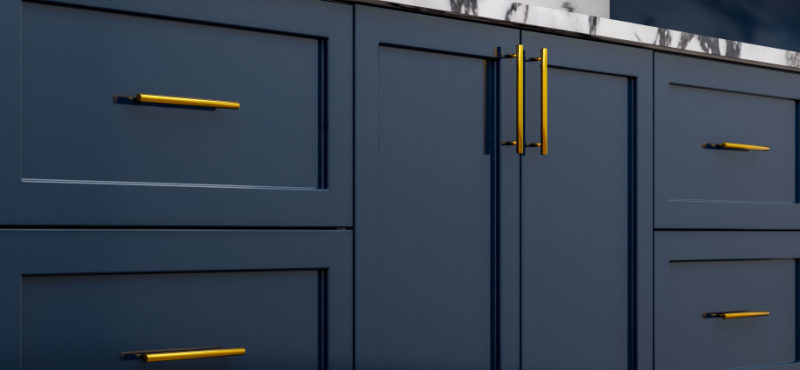Molding makes up for an important finish touch for any cabinet and as such should be treated with care and consideration. The choice of molding can have a major impact on the overall look of the kitchen, so choosing the right type of molding for your cabinets is imperative.
Various types of moldings can be used to enhance the appearance of kitchen cabinets. These moldings can add decorative elements, create architectural interest, or provide a seamless transition between different components of the cabinetry. Here are some common types of moldings for kitchen cabinets:
- Crown Molding: Crown molding is applied at the top of the cabinets, where they meet the ceiling. It adds an elegant touch and creates a smooth transition between the cabinets and the ceiling. Cabinets with smaller reveals benefit a lot from crown molding since their visible reveal will depend on the specific molding you choose.
- Light Rail Molding: Light rail molding is installed underneath the bottom edge of the wall cabinets. Its purpose is to conceal under-cabinet lighting fixtures, providing a neat and finished look. If you are planning on accentuating your kitchen with luminaries, light rail molding can be used to enhance the overall finish.
- Scribe Molding: Scribe molding is used to fill any gaps between cabinets and walls or other uneven surfaces. It is usually a thin strip of wood that can be trimmed or sanded to fit perfectly, ensuring a seamless and professional finish. If you have too many protruding surfaces, consider adding scribe molding to create harmony between uneven surfaces.
- Base Molding: Base molding is applied at the bottom of the base cabinets, covering the toe kick area. It adds a decorative element to the base cabinets and provides a cohesive look. You can use them as an extension of panels skins on islands and peninsulas to create a furniture-like feel.
- Toe Kick Molding: Toe kick molding is installed at the bottom of the base cabinets, directly above the floor. It helps to create a recessed space for your feet when standing in front of the cabinets and protects the cabinet base from accidental kicks.
- Dentil Molding: Dentil molding is a decorative molding that features repeating blocks resembling teeth. It can be used to add a traditional or classic look to the cabinets. Whether you go for contemporary or traditional kitchen-style cabinets, dentil molding can be a great way to add a unique finish to your kitchen.
- Panel Molding: Panel molding is typically used on cabinet doors to create raised or recessed panels. It adds depth and dimension to the doors, giving them an elegant and sophisticated appearance. If you have kids in the house, panel moldings can also be used as a safety feature to allow kids access to the cabinets.
- Beadboard Molding: Beadboard molding is characterized by a series of vertical grooves or beads. It is often applied to cabinet doors or sides to create a cottage or country-style look. They come in various colors and shapes so you can choose the one that suits your kitchen color scheme the best.
- Applied Molding: Applied molding refers to various decorative trim pieces that can be added to the face of the cabinet doors or drawer fronts. These moldings can include designs such as raised or recessed panels, arched shapes, or intricate patterns.
Work With Professionals
When it comes to kitchen cabinets, you want to choose a style that exudes your personality and ideas in the best shape and form. This is why working with a professional team who can help you visualize and execute ideas optimally is necessary. We at Tops Kitchen Cabinet have many years of experience and provide only the best-in-class cabinets and countertops. To learn more about our products or get a quote, give us a call today!

